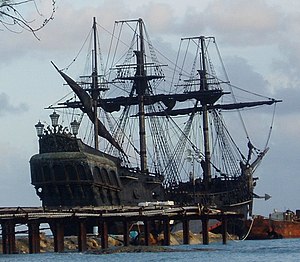Black Pearl
| The Black Pearl | |
|---|---|
| Pirates of the Caribbean | |

The Black Pearl on location
|
|
| Captain |
Jack Sparrow—3 years total (rightful Captain) Hector Barbossa—10 years + (due to mutinies against Jack Sparrow) |
| Type |
East Indiaman Galleon |
| Arms | 32 x 12-pound cannons |
| Appearance(s) | The Curse of the Black Pearl Dead Man's Chest At World's End On Stranger Tides |
The Black Pearl is a fictional ship in the Pirates of the Caribbean film series. In the screenplay, the Black Pearl is easily recognized by her distinctive black hull and sails. She was later raised from the sea floor by Davy Jones after making a pact with Jack Sparrow who rechristened her the Black Pearl. She is said to be "nigh uncatchable". Indeed, in the first three films she either overtakes or flees all other ships, including the Interceptor (regarded as the fastest ship in the Caribbean) and the Flying Dutchman (which is actually faster against the wind). Her speed is derived from the large amount of sails she carries. She is noted in At World's End as being "The only ship that can outrun the Flying Dutchman."
Originally named Wicked Wench (Wicked Wench is the name of the ship from the Pirates of the Caribbean attraction at Disneyland Park, which is shown shelling a fort), the ship was registered to the East India Trading Co. and owned by Cutler Beckett, the EITC Director for West Africa. At the time, Jack Sparrow was in the employ of the East India Trading Co. and was given captaincy of the Wicked Wench (this fits in with reality as history notes that pirates did not build ships specifically to commit piracy. Instead, they either bought or stole small, fast vessels, then retrofitted them with heavy armaments).
(As detailed in the 2011 Disney Publishing novel, Pirates of the Caribbean: The Price of Freedom, written by A.C. Crispin)
Jack Sparrow captained the Wicked Wench for Cutler Beckett for about a year, hauling various cargoes, but he refused to haul slaves. Hoping to recruit Sparrow as one of his many "operatives", Beckett indulged what he regarded as an odd peccadillo of Sparrow's until he and the captain came to a parting of the ways. Beckett had dispatched Sparrow on a mission to find the lost island of Kerma, and the treasure at the heart of its underground labyrinth, but Sparrow double-crossed the EITC official and claimed he couldn't locate the island. Suspicious that Sparrow had indeed found the island, and probably the treasure, but had not given him its accurate location, Beckett, determined to browbeat the captain into obedience, demanded that the young captain transport a cargo of slaves to the New World. Initially Sparrow agreed, but when he realized that he was betraying the Wicked Wench, as well as himself, he rebelled and freed the slaves by taking them to Kerma for safe asylum. Furious that Sparrow had flouted his orders and stolen the "cargo" of "black gold", Cutler Beckett had Sparrow thrown into jail. After allowing him to languish for a couple of months, he had him transported to the Wicked Wench's anchorage, about a mile from the coast of West Africa, near Calabar on the Bight of Benin. After personally branding Sparrow with the "P" brand (so he'd be forever branded a pirate) Cutler Beckett gave the order to loose carcass charges at his own ship, the Wicked Wench, in order to totally demoralize his prisoner. Sparrow fought his way free from his guards, dove overboard and attempted to rescue his burning, foundering ship, but he was too late. The Wicked Wench turned into an inferno, then sank, taking Jack with her. But, while dying, the resourceful Sparrow called upon Davy Jones, and struck a bargain with him...his soul and one hundred years serving aboard the Flying Dutchman in return for a continued human existence of thirteen years as captain, plus saving the Wicked Wench and transforming her into the fastest, most dangerous pirate ship sailing the seven seas. Jack christened his resurrected Wench, now a black vessel with an angel figurehead, The Black Pearl.
...
Wikipedia
